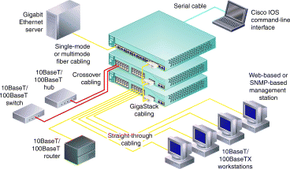Fully Switched Networks
In a fully switched network, switches replace all the hubs of an Ethernet network with a dedicated segment for every node. These segments connect to a switch, which supports multiple dedicated segments (sometimes in the hundreds). Since the only devices on each segment are the switch and the node, the switch picks up every transmission before it reaches another node. The switch then forwards the frame over the appropriate segment. Since any segment contains only a single node, the frame only reaches the intended recipient. This allows many conversations to occur simultaneously on a switched network.
Switching allows a network to maintain full-duplex Ethernet. Before switching, Ethernet was half-duplex, which means that data could be transmitted in only one direction at a time. In a fully switched network, each node communicates only with the switch, not directly with other nodes. Information can travel from node to switch and from switch to node simultaneously.
Advertisement
Fully switched networks employ either twisted-pair or fiber-optic cabling, both of which use separate conductors for sending and receiving data. In this type of environment, Ethernet nodes can forgo the collision detection process and transmit at will, since they are the only potential devices that can access the medium. In other words, traffic flowing in each direction has a lane to itself. This allows nodes to transmit to the switch as the switch transmits to them -- it's a collision-free environment. Transmitting in both directions can effectively double the apparent speed of the network when two nodes are exchanging information. If the speed of the network is 10 Mbps, then each node can transmit simultaneously at 10 Mbps.
